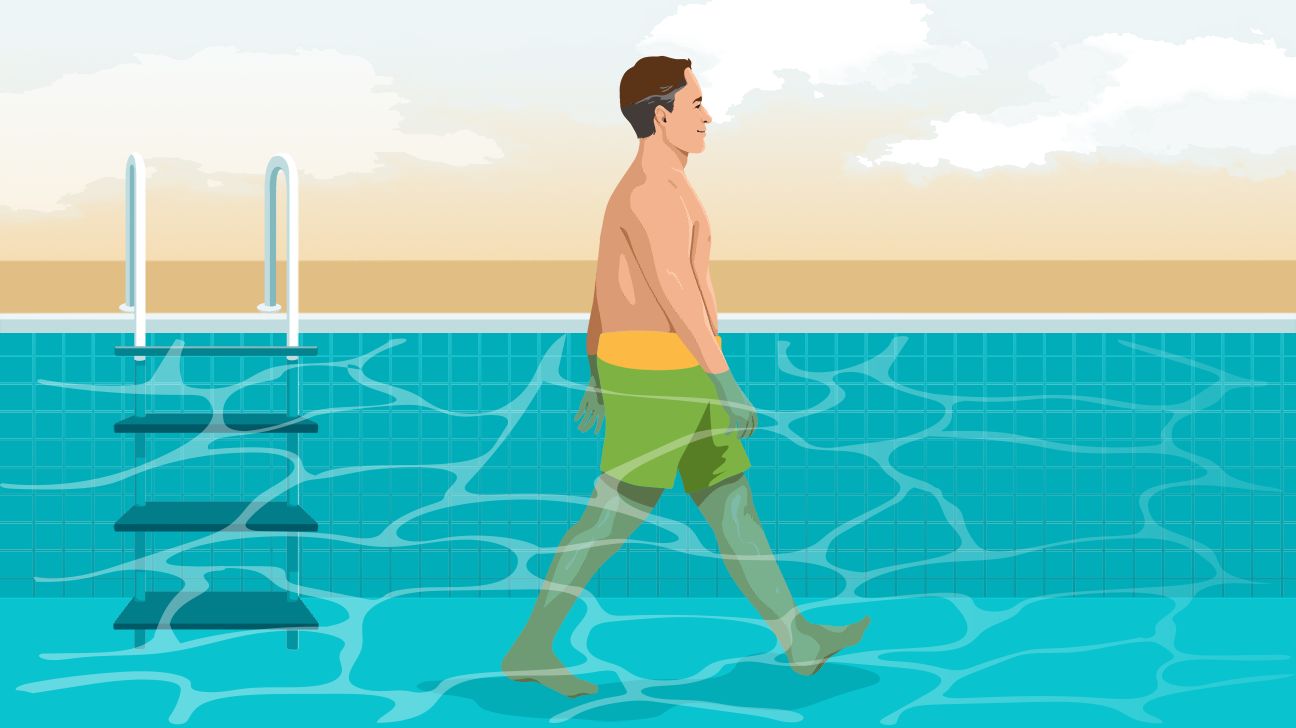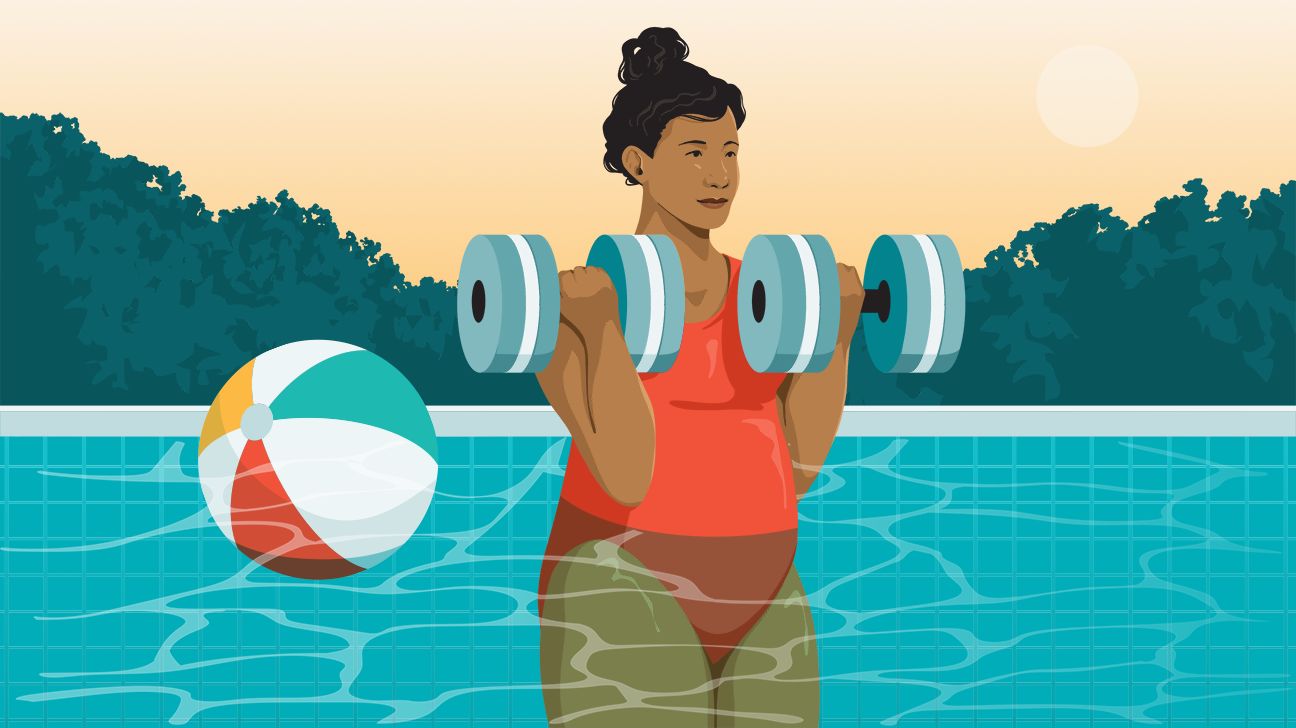Exercise is great for people living with Crohn’s — and doing these exercises in the water is even better.
Exercise can offer significant benefits to people with Crohn’s disease.
A
Low impact, water-based exercises might be especially appropriate for people with Crohn’s.
People with IBD are
Physical therapist Dr. Gregory Minnis explained how aquatic exercises can offer particular benefits.
“Water provides a natural body weight support system. So you’re putting a lot less ground reaction force or stress through your joints,” he said.
These benefits extend to people living with Crohn’s.
“Crohn’s is an inflammatory disease. If you have global inflammation, you might have joint aches or pains. So the water would be a more comfortable place to exercise because it would take stress off those joints and muscles,” said Minnis.
There are many ways to get the benefits of low impact water exercises if you have Crohn’s. Below are some exercises you might want to try.
This exercise involves walking through water at varying depths.
“Walking is obviously a great exercise because it’s functional,” explained Minnis. “It’s a good way to get your heart rate up to improve cardiovascular health.”
Here’s one way to do it:
- Stand in water about waist deep.
- Walk forward 10 to 20 paces. Swing your arms forward as you would on land.
- Walk backward the same distance.
You can make this exercise more challenging by walking in deeper water. You can also add resistance by carrying hand weights. Try to keep your back straight and avoid walking on tiptoes.
For this exercise, you’ll need foam barbells, which are light weights designed for use in the water. You can also do this exercise without weights and rely on the water for resistance.
Here’s what to do:
- Stand in water about waist deep.
- Hold the barbells at your sides with your palms facing up.
- Raise the barbells by bending your arms at the elbows. Keep elbows close to your waist.
- Turn your hands so the palms face down.
- Push your arms down at the elbows until they are straight.
- Repeat 12 to 15 times.
“On the way up and the curl, you’re going to strengthen your biceps,” said Minnis. “Then, when you’re straightening and extending the elbow, you’re going to strengthen your triceps. So you can work two opposing muscle groups with one exercise.”
As with bicep curls, leg extensions work two opposing muscle groups: the quadriceps and the hamstrings.
Here’s how you can work them out in the water:
- Stand at the edge of the pool in about waist-deep water. Stabilize your body by holding on to the pool wall or exercise bar.
- Extend one leg out about hip height with the leg straight.
- Bend the leg at the knee 90 degrees.
- Straighten the leg.
- Repeat 12 to 15 times.
- Repeat with the opposite leg.
You can tie a pool noodle around your foot for extra resistance.
You can do forward lunges with your hand on your hips, or you can hold onto the side of the pool for greater stability.
Here’s what to do:
- Stand in waist-deep water.
- Take one big step forward. Keep your knee in a straight line above your toes (and your head above water).
- Return to the start position.
- Repeat with the other leg.
- Repeat 12 to 15 times.
Minnis noted the functional benefits of lunges: “This is a good gluteal exercise and strengthens your quadriceps, which are important for standing and climbing stairs. And it improves hip mobility.”
Hip kickers are another exercise that can help with hip mobility.
Here’s how you can do hip kickers in a pool:
- Stand at the side of the pool with one hand on the pool wall for support in about waist-depth water.
- Keep the leg closest to the pool wall straight and perform the exercise with the other leg.
- Swing your outer leg up, keeping the leg straight.
- Return to the starting position.
- Swing your outer leg to the side, keeping the leg straight.
- Return to the starting position.
- Swing your outer leg backward, keeping the leg straight.
- Return to the starting position.
- Turn your body and repeat the exercises with your other leg.
Sidestepping is another option for pool exercise:
- Stand in waist- or chest-deep water.
- Clasp your hands together at your chest.
- Extend one leg out to the side.
- Bring your other leg together to meet your first leg.
- Proceed to take side steps along the length of the pool.
Squat jumps in water are similar to this exercise on land. They provide benefits to many muscle groups.
“Squat jumps are a great exercise for your calves, your back, your quadriceps, and your glutes,” said Minnis. “So it’s a great, almost total body exercise.”
Instead of doing a full jump, you can also simply move from a standing to a squatting position.
Here’s how:
- Stand with legs hip-width apart in waist-high water.
- Extend your arms straight ahead or clasp your hands behind your head.
- Bend your knees and lower your body into a squat position. Keep your back straight.
- Jump up or stand and bring your arms to your side.
- Land on the balls of your feet and lower your heels.
- Bend into a squat position.
- Repeat.
This toe touch with knee cross exercise resembles some movements of the game Hacky Sack.
“This improves your hip external rotation, mobility, and your gluteal strength,” explained Minnis. “It’s a good functional exercise because you need that hip mobility to put on your shoes and socks and put your pants on and take them off.”
Here’s how to do it:
- Stand in chest-high water.
- Lift your right leg with your knee bent and hip rotated open.
- Extend your right arm for balance.
- Tap your right ankle with your left hand.
- Return to the start position.
- Repeat with the opposite side.
- Repeat several times.
Here’s how to do jumping jacks in water:
- Stand in waist-high water.
- Place your feet together and your arms at your sides.
- In one quick motion, extend your arms above your head and move your legs hip-width apart.
- Return to the start position.
- Repeat.
You can modify jumping jacks by standing in chest-high water and bringing your arms only up to the level of the water.
Physical activity might help lower disease activity if you have Crohn’s. Low impact water exercises can relieve pressure on your joints while offering cardiovascular and muscle-strengthening benefits.



